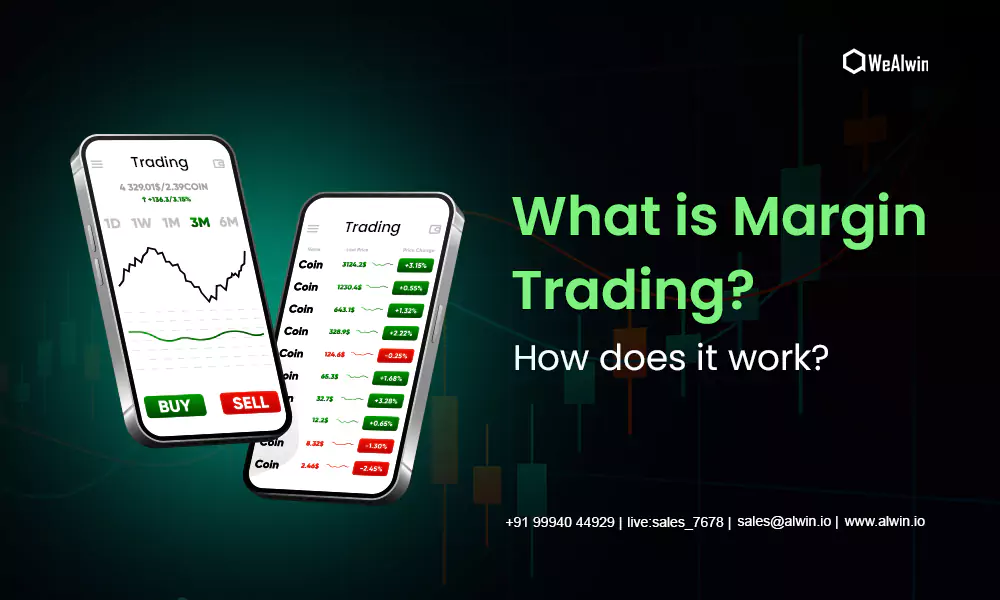In the world of finance, Margin Trading is a concept that allows investors to trade with borrowed funds, thereby amplifying both potential gains and losses. This article aims to provide a comprehensive understanding of Margin Trading, including its definition, mechanics, and benefits.
Whether you're a seasoned investor or a beginner exploring new investment strategies, this article will equip you with the knowledge needed to navigate the world of margin trading successfully.
What is Crypto Margin Trading?
Margin trading is a practice where investors borrow funds from a brokerage firm or exchange to trade assets beyond their available capital. It involves using leverage to magnify the potential returns on investment, enabling traders to access larger positions than what their capital would typically allow. This borrowed amount is referred to as "margin."
How Does Crypto Margin Trading Work?
To engage in Margin Trading, an Investor must open a margin account with a brokerage firm or exchange that offers this service. The broker usually requires an initial deposit to serve as collateral for the borrowed funds. Once the account is set up, investors can borrow a specific ratio of funds in relation to their deposited collateral. This ratio is known as the "margin requirement."
Step 1: Opening a Margin Account
To begin margin trading, an investor needs to set up a margin account with a brokerage firm or exchange that offers this service. This account is distinct from a regular cash account, as it permits borrowing. The process usually involves submitting an initial deposit, which serves as collateral for the borrowed funds.
Example: Imagine you have $10,000 to invest in the stock market. You open a margin account with a brokerage firm, depositing this amount. This initial deposit acts as security for any potential losses incurred through margin trading.
Step 2: Margin Requirement
A crucial component of margin trading is the margin requirement. It specifies the percentage of borrowed funds relative to your deposited collateral. Let's say the margin requirement is set at 50%. This means you can borrow up to 50% of the $10,000 you've deposited, which equates to $5,000.
Example: With a margin requirement of 50%, you now have access to an additional $5,000 in borrowed funds, effectively doubling your buying power in the market.
Step 3: Leveraging Your Position
Leverage is the key advantage of margin trading. In our example, for every dollar of your own capital ($10,000), you can control two dollars of assets ($10,000 + $5,000) through the borrowed funds. This potential for higher leverage is what makes margin trading attractive to many investors.
Example: You decide to buy shares of a tech company that cost $15,000 in total. Thanks to the borrowed $5,000, you can now afford to make this purchase. If the stock's value increases, your potential profits are magnified. However, if the stock's value decreases, your potential losses are also amplified.
Types of Crypto Margin Trading
There are two main types of margin trading: buying on margin and short selling.
Buying on Margin
Buying on margin refers to borrowing funds to purchase an asset with the anticipation that its value will increase. By leveraging borrowed funds, investors can increase their potential returns. However, if the value of the asset declines, losses are also magnified.
Short Selling
Short selling involves borrowing assets from a broker and selling them with the expectation that their value will decrease. Traders aim to profit from falling prices by buying back the borrowed assets at a lower price and returning them to the lender. Short selling allows investors to benefit from both rising and falling markets.
Margin Calls
One crucial aspect of margin trading is the concept of a margin call. A margin call occurs when the value of the investor's positions falls below a certain threshold set by the broker, resulting in a request for additional funds or the liquidation of assets to cover the loss. It's essential to understand the margin requirements and have a plan in place to meet potential margin calls to avoid forced selling and further losses.
The Risks of Crypto Margin Trading
While margin trading offers the potential for higher profits, it also involves significant risks that investors need to consider.
Increased Volatility
By using leverage, margin traders subject themselves to higher volatility. Even small price movements can have a substantial impact on the overall value of their positions, potentially resulting in significant gains or losses.
Magnified Losses
Leverage amplifies both gains and losses. While it increases the profit potential, it also exposes traders to greater losses, as a decline in the value of the asset will result in a proportionally larger loss.
Margin Calls and Forced Liquidation
If the value of the assets held in a margin account decreases significantly, it may trigger a margin call. Failing to meet the margin call requirements can lead to the forced liquidation of assets at potentially unfavorable prices.
Interest Payments
When using borrowed funds for margin trading, investors are required to pay interest on the borrowed amount. It's crucial to factor in these interest charges when calculating potential returns and considering the affordability of the strategy.
The Benefits of Crypto Margin Trading
Margin trading, when used wisely, can provide several benefits to investors.
Increased Potential Returns
By utilizing leverage, margin trading allows investors to access larger positions than their capital would normally permit. This increases the potential for higher profits if the trade goes in their favour.
Diversification of Portfolios
Margin trading provides an avenue for diversifying an investment portfolio. By accessing a wider range of assets and markets, investors can spread their risk and potentially enhance their overall returns.
Short Selling Opportunities
Margin trading enables investors to profit from falling markets through short selling, providing a valuable tool for risk management and maximizing investment opportunities.
Frequently Asked Questions (FAQs)
What factors should I consider before engaging in crypto margin trading?
Factors to consider include your risk tolerance, financial stability, knowledge of the market, and the ability to meet margin calls.
Can I use crypto margin trading for long-term investments?
While crypto margin trading is typically associated with short-term trades, it can be used for long-term investments. However, careful risk management and monitoring are crucial in such cases.
Is crypto margin trading suitable for beginners?
Crypto margin trading is generally not recommended for beginners due to the increased risks involved. It requires a solid understanding of the market and risk management strategies.
What happens if I can't meet a margin call?
Failing to meet a margin call may result in the forced liquidation of assets in your margin account at potentially unfavorable prices.
Are there any alternatives to crypto margin trading?
Yes, there are alternative investment strategies such as dollar-cost averaging, diversification, and long-term investing that can provide more stability and lower risk.
Conclusion
Crypto margin trading offers investors the opportunity to amplify potential gains and diversify their portfolios. However, it comes with inherent risks due to increased volatility and potential losses. It is essential for investors to fully understand the mechanics, risks, and benefits associated with margin trading before engaging in this investment strategy.
Remember to always do thorough research and consult with a financial advisor before engaging in margin trading or any investment activity.



